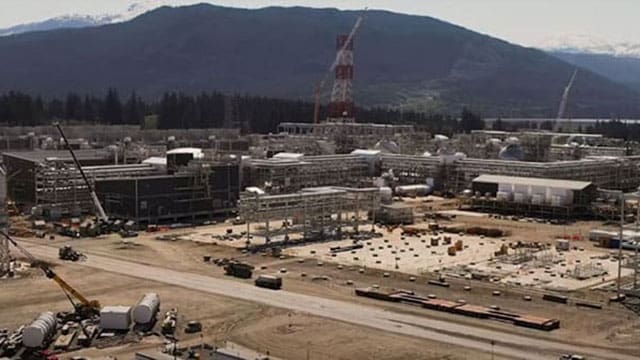Canada can reduce global emissions and boost the economy by exporting LNG to Asia
 Pierre Poilievre‘s Axe the (carbon) Tax campaign is a spectacular success. But the Conservative party needs its own plan to reduce fossil fuel emissions. Paradoxically, it’s a fossil fuel that provides the answer.
Pierre Poilievre‘s Axe the (carbon) Tax campaign is a spectacular success. But the Conservative party needs its own plan to reduce fossil fuel emissions. Paradoxically, it’s a fossil fuel that provides the answer.
Canada’s rich endowment of natural gas offers us the chance to both reduce global emissions and also rescue a Canadian economy ravaged by the Trudeau government. How? By exporting liquefied natural gas (LNG) to China, Japan, South Korea and other coal-dependent Asia-Pacific countries. Switching from coal to natural gas reduces CO2 emissions by 50 percent while also eliminating the toxic compounds and lung-clogging particulates that shorten the lives of millions living in smog-stricken Asian cities.
A November 2022 study by respected consulting firm Wood Mackenzie concluded that:
- Canada is well-positioned geographically: Western Canadian LNG is much closer to Asia relative to U.S. Gulf Coast LNG, which needs to be shipped to Asia through the Panama Canal to get to Asia.
- LNG from Canada would be cost-competitive for northeast Asian importers … due to its relatively low shipping and liquefaction costs.
- LNG from Canada has a lower intensity of emissions than LNG from many other global LNG exporters.
- Asia will not be able to produce enough natural gas domestically to meet its escalating demand. With its high environmental standards and stewardship, Canada would be a great partner to fill the LNG demand gap in Asia.
- If Canada aggressively ramps up its LNG exports, the emissions displaced would total 5.5 (billion tonnes of carbon dioxide) from 2022 to 2050 … the equivalent of removing all Canadian cars from the road.
In 2010, there were more than 20 LNG projects in the works in British Columbia, representing hundreds of billions in total investment. These included Exxon Mobil’s $25-billion West Coast Canada project, Chinese-owned CNOOC’s $36-billion Aurora project, Malaysian firm Petronas’s $36-billion Pacific Northwest project and the Shell-led $31-billion Kitimat LNG Canada project. After a decade of trying to navigate Canada’s byzantine regulatory process, LNG Canada is the only one left standing. And it succeeded only because South African project leader Andy Calitz refused to give up.
After five years of construction, the LNG Canada terminal is nearing completion, with the first ship scheduled to sail to China in mid-2025. The $31 billion invested in the Kitimat liquefaction plant is just one component of Canada’s first LNG export project. TC Energy Corp’s $15-billion Coastal GasLink will carry natural gas from the northeastern B.C. gas fields to the Kitimat terminal. In addition, hundreds of millions of dollars have been invested in natural gas wells and field production systems.
The economic benefits are myriad. B.C. natural gas royalties are forecast to double, from $700 million in 2024 to $1.4 billion in 2027. There are significant employment and business opportunities for First Nations, including Haisla Marine’s 50 percent interest in a $500-million contract.
That’s just LNG Canada Phase 1. Construction of another 14 million tonnes per year LNG Canada Phase 2 is scheduled to begin in 2026, with first delivery in 2032. A report from Canada Action estimates that completion of both phases of LNG Canada alone is equivalent to removing 18 million cars from Canadian roads.
A major barrier for LNG project sponsors has been the fixation of Canadian regulators on the project’s domestic emissions, which are minuscule compared to the global emissions reductions they make possible. Rather than let the project use on-site natural gas-powered electricity generation, regulators insisted that LNG Canada use zero-emissions hydropower. Having BC Hydro build a new dam and costly new transmission line delayed the project significantly.
Before COP24, the UN Climate Change Conference in Katowice, Poland, in 2018, the federal Conservatives urged the leaders of the Canadian delegation to propose that national emissions reductions include reductions from displacement of coal with exported LNG. Prime Minister Trudeau and his team of anti-fossil fuel eco-zealots declined this advice. A new government that encourages LNG projects may well see a return of the Exxon-Mobil, CNOOC and Petronas projects driven off by government intransigence.
As an alternative to the carbon tax, LNG export not only does better in emissions reduction but also creates tens of billions of dollars in economic benefits for a beleaguered Canadian private sector. Stepped-up LNG export is a vastly superior environmental alternative to the economically destructive and politically divisive carbon tax, and it would help reverse a proud, thriving nation’s decline into an indebted, unproductive, government-dominated basket case.
Gwyn Morgan is a retired business leader who has been a director of five global corporations.
For interview requests, click here.
The opinions expressed by our columnists and contributors are theirs alone and do not inherently or expressly reflect the views of our publication.
© Troy Media
Troy Media is an editorial content provider to media outlets and its own hosted community news outlets across Canada.


